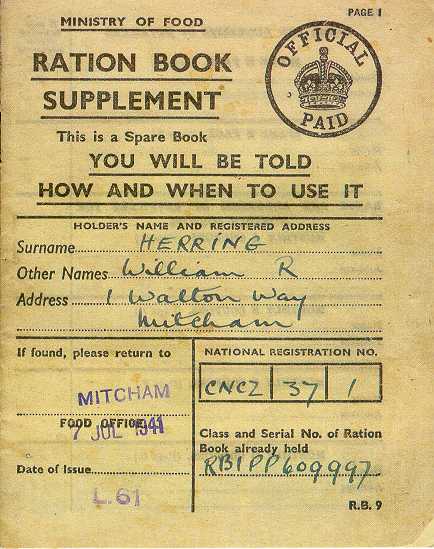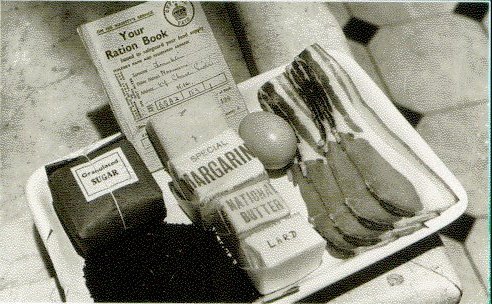It was envisaged that should war come, a majority of factory production would be concentrated on the war effort. As this would result in a smaller number of clothes, food and other household goods being produced, it was decided that there had to be a way of allocating these limited goods equally and fairly to the population. Rationing was born.
With the introduction of rationing in the early days of world war two, much frustration came about. Rationing saw images of ration cards, endless queues (though many of these queues were more often for luxury goods such as cakes, sausages and sweets than the more basic foods) and utility clothing.
The Minister of Food, Lord Woolton, offered novelty food suggestions such as whale meat (whose odd flavour could only be subdued by overnight soaking in vinegar!), and such recipes as Woolton Pie, carrot fudge, poor man's goose and sultana casserole. He also ensured every child under the age of three received daily milk, cod liver oil and orange juice to boost their vitamin intake and those under five, cod liver oil. Free school meals were also allocated to those children of poorer families.
Despite the British people having to go without, on the whole rationing did mean that the nation was much better fed than it had been in the 1930's. People preferred equality to a free for all in which the 'well-off' would stockpile food and the poor go hungry.
Undoubtedly while everyone was hungry in wartime Britain, no one starved.
Although rationing resulted in food being plain and boring throughout the war, it effectively helped to win the war - as a Ministry of food advertisement boasted;
A tentative start was made with the introduction of rationing. Among the first foods to be rationed were the following in January 1940:
This was later followed by meat in March 1940 and tea (2 oz per person, weekly) in July 1940.
These items were later extended to include preserves (jam, margarine, syrups and treacle), sweets, cheese, cooking fats and eggs (1 egg per person, weekly).

PICTURE: Ration cards were actually prepared in 1938, issued to the British general public on Monday 8th September 1939 and started on 8th January 1940
Everyone had their own ration book to help them keep track of goods. These ration books were full of coupons which were cut out and used to buy a fixed amount of rationed foods each week/month. For example, each time sugar was bought, the sugar coupon was handed over to the shop keeper. This meant that if all of the sugar coupons were used up for the week, you had to wait until the next week for more.
A 'point' scheme was introduced for non-rationed foods. Each person was allocated a number of points and a selected range of foods was given a point value. The consumer could choose how to spend these points.
Under rationing milk and eggs were strictly controlled. Expectant mothers were entitled to a little extra but even this was still less than what they had been used to. Eggs were usually substituted with the 'tasteless' dried powdered eggs.
Land previously used for dairy cattle was churned up for crop growth, making milk availability even more scarce.

PICTURE: A typical weeks rations - could you have survived on this?
These weekly rations were stretched with the help of un-rationed extras like bread (incidentally not rationed until after the war), cereal, potatoes, offal and fruit and vegetables.
In addition to the rigid rationing of food, clothes were also rationed and controlled by the issue of clothing coupons.
Beginning on 1st June 1941, every individual was allocated a maximum of just 66 clothing coupons per annum. This equated to just one complete outfit a year!
In 1942, a utility scheme was introduced to limit the amounts of material used in the making of clothes - For example:
Woman’s nightdress
6 coupons
Man's overcoat
16 coupons
Dress
11 coupons
Underpants
4 coupons
Handkerchief
1/2 coupon
Pyjamas
8 coupons
blank
blank
The list above illustrates the number of coupons needed to buy certain garments
With these clothing restrictions, much was done to encourage women to repair old family clothes or 'recycle' old clothing by (for example) unravelling the wool of old unwanted jumpers and knitting it into something else, and other such like suggestions. Some of these unravelled sweaters were also knitted into socks and scarves for the British troops.
Campaigns like 'Mrs Sew-and-Sew' and 'Make Do and Mend' did much to bolster ideas, often sparking off innovations of how to create new clothing using old materials. It wasn't unheard of for old curtains to be made into skirts or dresses, or for women to draw lines down the backs of their legs to give the impression that they were wearing stockings! This stockings shortage being of course as a result of many nylon factories being used during the Second World War for the arms production.
Also affected by rationing were other goods like furniture. As people couldn’t replace or repair their homes, they grew shabbier as the war went on.
Utility furniture was designed to use as little wood and other raw materials as possible. It was made available, however, only to newly weds and civilians who had lost everything as a direct result of air raid bombings.
Designs of materials used in the production of plates, saucepans and umbrellas were also tightly controlled – as a example, cups were often white with no handles.
Shortages of petrol meant fewer vehicles on the road and a greater reliability on public transport, which in itself was also restricted.
Cosmetics such as soap were also in short supply and as a consequence rationed.